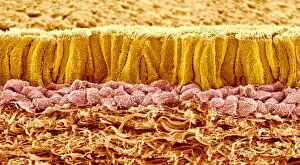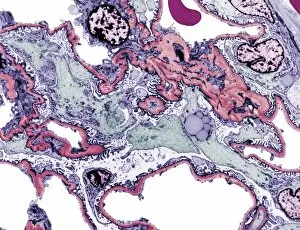Basement Membrane Collection
The basement membrane, a vital component of various tissues and organs, plays a crucial role in maintaining their structural integrity
All Professionally Made to Order for Quick Shipping
The basement membrane, a vital component of various tissues and organs, plays a crucial role in maintaining their structural integrity. In the trachea lining, as observed through scanning electron microscopy (SEM) images C015 / 9936, the basement membrane acts as a supportive scaffold for the delicate epithelial cells that line the respiratory tract. Similarly, in seminiferous tubules captured using transmission electron microscopy (TEM), this thin but resilient layer provides support to developing sperm cells. Moving on to another example from TEM imaging, we see how the basement membrane supports the epithelium of the epididymis. This intricate network ensures proper functioning and transport of mature spermatozoa along their journey towards fertilization. Returning to SEM imagery with tracheal lining C015 / 9939, we witness once again how this remarkable structure maintains tissue organization and prevents damage during respiration. The basement membrane's resilience is further highlighted when examining intestinal arterioles under TEM; it serves as an anchor for blood vessels within these vital digestive organs. As we delve deeper into TEM images showcasing intestinal arterioles repeatedly, it becomes evident that this specialized form of connective tissue is essential for ensuring efficient nutrient absorption and waste elimination within our bodies. However, not all instances involving they are positive. Hydronephrosis presents itself as an abnormal condition where urine accumulates due to obstruction or other kidney diseases seen through TEM analysis. Here we witness how disruptions in normal basement membrane function can lead to severe complications affecting renal health. Whether supporting respiratory functions in tracheal linings or aiding reproductive processes in seminiferous tubules and epididymis epitheliums - or even facilitating nutrient exchange within intestinal arterioles - understanding the intricacies of basement membranes is key to comprehending numerous physiological processes while also highlighting potential issues such as hydronephrosis or kidney disease.








